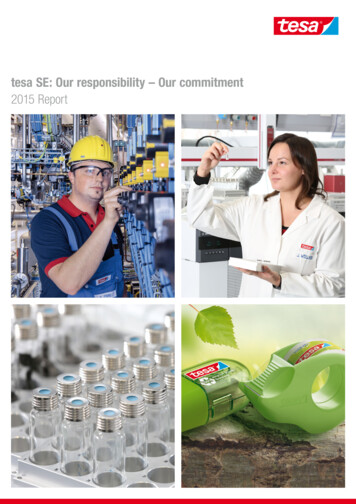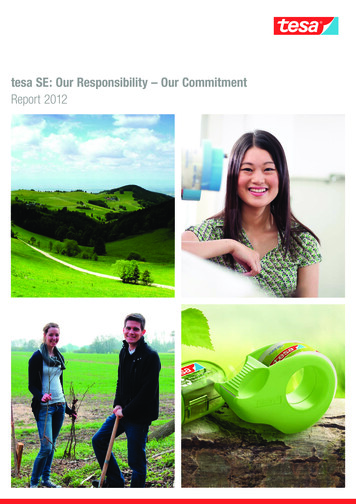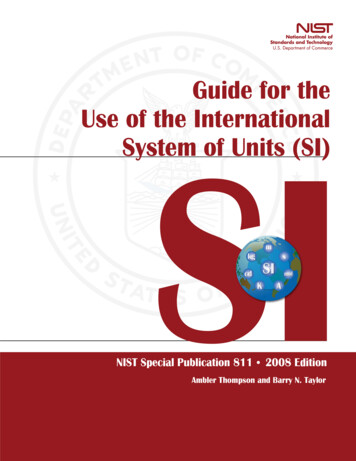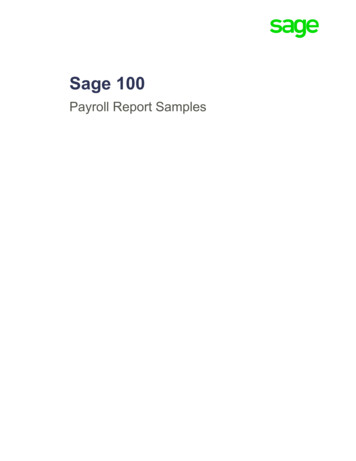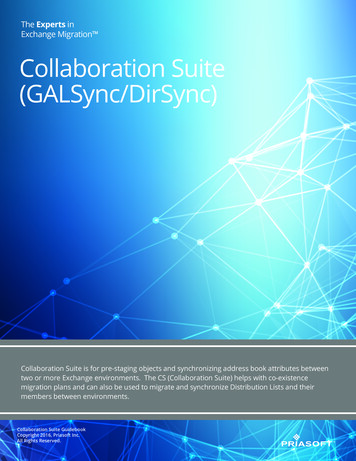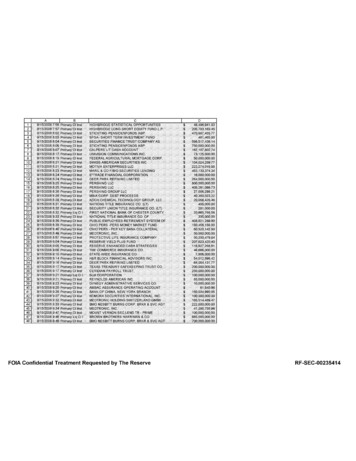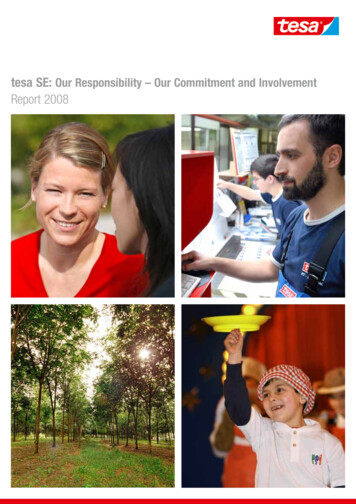
Transcription
tesa SE: Our Responsibility – Our Commitment and InvolvementReport 2008
A vivid tradition of responsibilityUN Photo/Mark GartenGlobal CompactThe date: January 31, 2001. The location: the World Economic Forum, in Davos. Then-UN Secretary General Kofi Annancalls on companies that operate internationally to take an active stance in meeting the challenges presented byglobalization. His vision: a global pact based on universally accepted social and environmental principles.Today, companies from more than 80 countries, internationalemployee associations, civil society organizations, governments,and United Nations organizations are involved in the GlobalCompact. Under the auspices of the new UN Secretary General,Ban Ki-Moon, the world’s largest corporate citizenship initiative ismoving forward.The ten principles of the UN Global CompactPrinciple 1: Businesses should support and respect the protection of internationally proclaimed human rights; andPrinciple 2: make sure that they are not complicit in humanrights abuses.The ten principles on which the pact is based, which cover theareas of human rights, labor standards, environmental protection, and the fight against corruption, have long formed part ofthe corporate values of tesa. Our membership in the GlobalCompact underscores this vivid tradition.Principle 3: Businesses should uphold the freedom of association and the effective recognition of the right to collective bargaining;Principle 4: the elimination of all forms of forced and compulsoAll of tesa SE’s activities related to commitment and involvementare subject to a continuous improvement process. We publishedour first Global Compact Report for 2006/2007, and now wehave documented our most recent activities in the current issue,the Communication on Progress 2008, which highlights ourprogress with regard to the ten principles of the UN Global Compact and our own corporate social responsibility strategy.ry labour;Principle 5: the effective abolition of child labour; andPrinciple 6: the elimination of discrimination in respect of employment and occupation.Principle 7: Businesses should support a precautionary approach to environmental challenges;Principle 8: undertake initiatives to promote greater environmental responsibility; andPrinciple 9: encourage the development and diffusion of environmentally friendly technologies.Principle 10: Businesses should work against corruption in all itsforms, including extortion and bribery.2
Communication on Progress 2008As a member of the United Nations Global Compact, we havecommitted to report annually on the progress of our initiatives.This helps facilitate a regular interchange of information withthose around us and documents our projects aimed at puttingthe ten principles of the Global Compact into practice.The Communication on Progress 2008 provides you with anoverview of our worldwide commitment and involvement in thefields of human rights and labor standards, environmental protection, the fight against corruption, and society. tesa has traditionally pursued a continuous improvement process. With 51affiliates spread across different countries worldwide, there is alarge number of projects involved. For that reason, this report islimited to a representative selection of initiatives that have beenundertaken for the first time or recently concluded.In line with the communication channels used by our stakeholders, the Communication on Progress 2008 also marks the switchfrom a printed version to an online one. Beyond the advantageof better accessibility, an online report also offers opportunitiesfor active dialogue and regular updates. You can also visit ourResponsibility Web pages on www.tesa.com/responsibility forcomprehensive information on the topics of the environment,quality, employees, and social matters.Declaration of SupportHuman Rights and Labor StandardsMembership based on firmly held convictionsThe human factorWe are firmly convinced that binding values and a sustainablebusiness policy are prerequisites for economic success. page 4Conduct guidelines and new activities in the areas of fosteringemployee qualifications and occupational health and safety leavetheir mark on 2008. page 5Environmental ProtectionFighting CorruptionWorldwide initiativesProper conductAt present, tesa is making progress on over 60 environmentalprojects. Examples from the areas of energy, solvents, waste,and certification. page 10In our Code of Conduct and Purchasing Charter, we take a clearstance on the rules of conduct that apply on a binding basis attesa. page 16Social ProjectsStrategy with regional facetsWith its focus on children and young people, our social commitment and involvement is reflected in over 40 projects worldwide. page 173
Declaration of Support“The UN Global Compact corresponds to our own values andthe sustainable business policy implemented by tesa.”In its role as one of the world’s leading manufacturers of selfadhesive system solutions, tesa offers innovative products forindustry and trade, and for consumers. Each and every one ofthose products was invented to solve a problem. We can nowlook back over more than 100 years of history as a brand andextremely successful international development. Many differentpeople have contributed to this, right up to the present day.We are firmly convinced that having a business policy that isdesigned for sustainability is an absolute prerequisite for economic success. This idea has been reflected in our values andactions over generations. Our membership in the United NationsGlobal Compact underscores this approach and provides a wider framework for our ecological and social activities.We implement the ten principles of the UN Global Compact in asystematic fashion. Wherever possible, we exert our influence andproactively seek to further promote our binding rules of conduct.In 2008, we created a firm basis for our values and guidelines bysetting them out in the tesa Code of Conduct and the tesa Purchasing Charter. These two steps have raised our profile as aresponsible “citizen of the world” while at the same time raising ourown expectations – expectations our partners and collaboratorsmust meet. Along our global value chain, all of the players arecalled upon to do their part to ensure sustainable development.In our capacity as a technology enterprise that both conductsresearch and produces goods, we take our responsibility forensuring a clean, healthy, and undamaged environment veryThomas Schlegel,Chief ExecutiveOfficer of tesa SEseriously. The tesa environmental goals, which apply worldwide,are aimed at fulfilling this responsibility and thus also form part ofour strategy. Areas of emphasis in this regard include economical consumption of raw materials and energy, prevention of unnecessary waste, and proper recycling. One particular focalpoint of our corporate strategy is the development and use ofinnovative, solvent-free production technologies. We alreadymanufacture the majority of our products using methods that arewater-based and therefore more eco-friendly.The idea of leaving as healthy and undamaged a world as possible behind for future generations is also at the core of our corporate social responsibility strategy. Our focus in this regard lieson assisting and supporting children and young people. Underthe auspices of a central steering committee, all of the companies in the tesa Group have the opportunity to design their socialinvolvement in ways that are specifically aligned to regionalneeds and concerns – in many cases with volunteer support.We will continue to act sustainably, following the spirit of the UNGlobal Compact, into the future. In times such as these, with adifficult world economic situation, it is all the more important toensure continuity, trust, and a long-term approach.4
Human Rights and Labor StandardsThe human factor as a determinant of successPeople are the very foundation of our business success – peoplelike our own employees as well as customers and suppliers. Withthis in mind, compliance with and furtherance of internationalhuman rights are just as much a part of our principles as unimpeachable labor standards. This reporting year, we pursuedthese principles with initiatives including the internationally appli-cable tesa Code of Conduct and the introduction of our worldwide tesa Purchasing Charter, which governs our cooperationwith suppliers. In addition, our below-average accident rates,numerous initiatives aimed at raising employee qualifications, andawards as an employer document our commitment and involvement in 2008.Code of ConductPurchasing CharterBinding rules of conductStandards for strategic purchasingThe tesa Code of Conduct sets out clear conduct guidelines –aligned to our values and the principles of the UN Global Compact. page 6The tesa Purchasing Charter defines our minimum standards,binding worldwide, for our cooperation with suppliers. page 7Employee QualificationOccupational Health and Safety ManagementAwards as a top employerBelow-average accident figuresOur employees are our most valuable capital. Our corporateculture and targeted employee support initiatives take this factinto account. page 8We raised our already stringent worldwide occupational healthand safety standards once again in 2008 and received twoawards. page 95
Code of ConductThe tesa Code of Conduct sets out clear conduct guidelines –aligned to our values and the principles of the UN Global Compact.Binding rules of conductRespect, honesty, trust, tolerance, and integrity – these are theprinciples we apply in our business, principles that have not onlymade us successful in the past, but will also continue to guideour actions into the future. To put these ideas even more firmlyinto practice worldwide, tesa SE established a mandatory codeof conduct in 2008. The conduct guidelines it contains are derived from our corporate values and the ten principles of the UNGlobal Compact.The tesa Code of Conduct applies all around the world. Its clearrules and criteria help us to create a guiding framework andstrengthen others’ trust in the performance and integrity of thetesa Group. No matter the position or title, we expect all employees to abide by our ethical principles and consistently apply themin everything they do. We demand that our executives not onlydemonstrate exemplary compliance with the rules of conduct,but also ensure at the same time that they are actively communicating the rules to others. All of our executives were required tocomplete an e-learning program on the Code of Conduct andthey will receive further support for the ongoing communicationprocess; we will provide them with presentations, for instance. Inaddition, at the beginning of 2009, the Code of Conduct wasmade an integral component of our introductory seminars fornew employees, training sessions for junior management talent,and our Sales Qualification Program.The Code of Conduct embodies our most important principlesacross six thematic areas:1. Compliance with laws and regulationsWe conduct business legally and ensure strict compliancewith the laws of the countries in which we operate.2. Fair competitionWe do not secure market advantages through unfair or illicitpractices.3. Protection of tesa assetsWe are careful in our dealings with the company’s proprietaryand copyrighted information, assets, and resources.4. Socially compatible working environmentWe ensure a socially compatible, safe, and motivational working environment. We categorically reject all forms of child labor, forced labor, discrimination, and similar practices. And weexpect our business partners to do the same.5. Personal integrityWe encourage the utmost in personal integrity and fairnessamong our employees and avoid situations in which personalinterests conflict, or could conflict, with those of our company.6. Social commitment and involvementWe take our responsibility toward future generations seriouslyand actively work toward sustainable development across allthe relevant sectors – in economic, ecological, and socialterms.Download „Code of ty/global compact/cop/human rights/code of conduct6
Purchasing CharterTo provide a standardized framework for our internationally applicable core principles,the Strategic Purchasing division of tesa established the tesa Purchasing Charter.Minimum standards for strategic purchasingWe at tesa are firmly convinced that sustainable, responsiblecorporate conduct must go beyond the individual company itself.That’s why our internal rules of conduct have long applied to ourcooperation with suppliers around the globe as well. To provide astandardized framework for our internationally applicable coreprinciples, the Strategic Purchasing division of tesa establishedthe tesa Purchasing Charter during this reporting year. Aligned tothe ten fundamental principles of the UN Global Compact, itspecifies the minimum standards we apply worldwide in the areas of human rights, labor standards, environmental protection,and the fight against corruption. Incorporated into our contractterms and conditions, they ensure that suppliers make a bindingcommitment to operate in accordance with the UN Global Compact.In our cooperation with suppliers, we put a high priority on acontinuous improvement process that includes jointly established goals and monitoring of the degree to which they are met,regular site visits, and certification under the ISO 14001 environmental standard and ISO 9001 quality standard. Starting in2009, we are also supporting compliance with our minimumstandards by implementing our SRM (supplier relationship management) process. Under this process, supplier qualification,evaluation, and development will follow the same systematicapproach throughout the entire tesa Group – from initial contactvia a questionnaire to in-plant product qualification and finally touniformly designed local rtaDownload „Purchasing Charter“7
Employee QualificationOur employees are the most important capital for securing our success.Our corporate culture and targeted employee support initiatives take this fact into account.Awards as a top employerAll over the world, employee integration and personnel development are among the most important factors contributing to oursuccess. Because of its excellent ratings in this area, the tesaplant in Offenburg was named one of the top employers of 2008by the magazine “Junge Karriere,” published by the Handelsblattpublishing group, and by the consulting firm CRF. This awardrates companies in the categories of compensation, market leadership, work-life balance, job security, development opportunities, and internal climate and culture. Providing important data,facts, and a specific points rating, the ratings give recent graduates and young professionals guidance for their career development.In 2008, the company also won a comparable title in Switzerland, where Swiss multimedia business magazine “Cash” chosetesa Bandfix AG as one of that country’s top employers. Theoutstanding rating, in which the wholly owned subsidiary of tesaSE ranked sixth out of 81 companies right off the bat, was basedon information from the company’s own employees. They gavetheir employer top marks in an extensive survey on organizationalstructures, corporate culture, management behavior, goals, performance incentives, and knowledge transfer.struction. We now offer training in 19 languages and have begunthe international rollout of our uniform global standards. In 2009we will continue the implementation of this international continuing education program, comprising 14 different training units,and train additional target groups.We promote international cooperation between our employeesthrough continuing education programs such as the Competencies Development Process, which involves a six-month projectcompleted alongside the employee’s regular work. The aim is notonly to have employees work conceptually on a specific focusproject, but also to ensure the personal development of participants, who are required to have three to five years’ managementexperience. With support from an external coach, they are ableto gain new perspectives outside of their own day-to-day working lives. Self-organization and international teamwork are amongthe particular skills participants learn. In 2008, one team focusedon the Eastern European market and its potential prospects fortesa scribos. The wholly owned tesa subsidiary offers effectivesecurity solutions to protect brand names and products fromtampering and counterfeiting.In the 2008 reporting year, we continued to expand our extensiverange of continuing education measures. As part of the SalesQualification Program, which was instituted the year before andis aimed at about 1,500 marketing and sales employees, wewere able to train about 800 participants over 320 days of in8
Occupational Health and SafetyWe raised our already stringent worldwide occupational health and safety standardsonce again in 2008 and received two awards.Below-average accident figuresPrevention is the best form of protection from injuries and jobrelated health risks. Our extraordinarily low accident rates demonstrate that we are on the right track with our occupationalhealth and safety initiatives and training measures at all of theplants. In 2008, this was reflected in factors that included twoawards from the Occupational Health and Safety Office of theCity of Hamburg: The agency gave both the tesa plant in Hamburg and tesa affiliate acos GmbH its highest rating, “companywith an exemplary occupational health and safety system.” Ourestablishment of concrete goals, below-average rate of accidents, and recording and assessment of even accidents that arenot required to be reported as well as the extensive programs inplace to promote health at the workplace weighed particularly inour favor.All around the world, tesa is subject to our Occupational SafetyGuidelines, which are aligned to the international OHSAS 18001standard. Regular employee training on conduct that is conducive to safety and health, prevention of explosions and fires, fireextinguishing drills, detailed operating procedures for all production facilities, and targeted employee training have ensured thatthe number of days of work missed due to occupational accidents subject to mandatory reporting fell once again in 2008.Since 2005, tesa has achieved an overall reduction averaging 11percent worldwide.At tesa, systematic identification and assessment of risks associated with potential hazards forms the cornerstone of our ability topreclude faults, mistakes, and improper conduct in advancewherever possible. In this context, in 2008 we were able to conclude the worldwide implementation of our top principle – ananalysis tool used to determine the causes of problems in threecategories: technical, organizational, and personal. And to further promote occupational health and safety on an internationallevel, we have also incorporated this topic into a regular exchange of information and experience between all of the technical executives at our affiliates.In 2009 as well, we plan to further expand on our occupationalhealth and safety system. For example, we will be introducinguniform processes for project planning of new systems and facilities. The aim of this initiative is to take precautionary measures toprevent potential hazards early on, even during the planning andconstruction phase.9
Environmental ProtectionWorldwide initiativesLeaving a clean, healthy, and undamaged environment behind forsubsequent generations is one of tesa’s stated corporate goals.In pursuing this aim, we take a precautionary approach, promoting the international exchange of information between our environmental experts and actively taking the initiative in pushingappropriate measures forward. This approach ranges from continuous monitoring of specific key indicators such as waste, CO2emissions, and energy use to developing our own technologiesfor solvent-free production. We also work specifically on productsthat help our customers – to save energy, for example – andmake sure that our suppliers apply comparable standards.In total, our environmental commitment and involvement encompasses more than 60 individual projects. By way of example, thesection that follows cites some of our initiatives in the fields ofenergy, solvent-free technologies, waste, and certification. Formore information on our environmental program and the pertinent guidelines and goals, please visit Responsibility/Environment. The content there also offers a look at our worldwide business processes as specified in the tesa Integrated ManagementSystem (IMS).Environmental Goals 2007 – 2012EnergyInternational activitiesHeat recovery drives down demandClearly formulated goals are the key to our ambitious environmental program, which encompasses projects spanning theentire globe. page 11Exemplary projects in Offenburg and Hamburg ensure reducedenergy use and CO2 emissions. page 12Reduced Solvent UseWaste ManagementInnovative technologiesRaising awarenessOur R&D-team uses innovative technologies to establish lowerimpact production processes that do not use solvents. page 13tesa reinforces its efforts to reduce waste and ensure properrecycling through initiatives aimed at raising awareness. page 14CertificationEnvironmental management system expandedHigh standards at our locations in China and Singapore impressed auditors during the process of obtaining certificationunder the ISO 14001:2004 environmental standard. page 1510
Environmental Goals: 2007 through 2012Clearly formulated goals are the key to our ambitious environmental program,which encompasses projects spanning the entire globe.International activitiesAfter the successful conclusion of our first environmental program, which ran from 2001 through 2006, we have once againset ambitious, binding goals for ourselves for the next five-yearperiod. The degree to which we meet these internationally applicable environmental goals is determined through a global monitoring program based in each case on constant productionquantities. Now, for the first time, our environmental goals for theperiod from 2007 through 2012 also include emissions of volatileorganic compounds (VOCs). Over the past two years, we havebeen able to reduce these emissions by 22 percent, thus alreadyexceeding our intermediate goal for 2008. The same also appliesto our use of solvents and energy: we have achieved a drop ofseven percent in both. We also posted a six-percent decrease inCO2 emissions for 2008.Environmental goals 2007 through 2012VOC Emission- 50 %Solvents used- 15 %Energy consumed- 10 %WasteCO2 Europe-5%- 10 %11
EnergyExemplary projects in Offenburg and Hamburg ensure reducedenergy use and CO2 emissions.Heat recovery drives down demandOne good example of our activities aimed at reducing our energyconsumption is the implementation of a new heat recovery system at the tesa plant in Offenburg. At that facility, all central heating units are connected via a feed and return line, along withcirculation pumps, so that waste heat generated during processes can be recovered and used for heating purposes. A central control unit ensures that the available energy is automaticallyfed into circulation.At the tesa plant in Offenburg, replacing the energy used forheating by recirculating waste heat generated during processesled to a drop of 9,000 megawatt-hours in 2008. As a result,emissions of harmful CO2 also fell, by nearly 2,300 metric tons. Inthe long term, the company hopes to use the positive experiencethe tesa plant in Offenburg is currently gaining with the new heatrecovery system to deploy this landmark technology at otherlocations as well.Another system for saving energy through heat recovery wasalso put into operation at one of the production buildings at thetesa plant in Hamburg, where a reduction of 200 megawatthours was achieved. The Hamburg location also secured additional energy savings by modernizing a polymerization facilityused to produce adhesive masses. A ventilation system used inthis facility, which had been optimized the year before, showedits first effects in 2008, successfully pushing energy use down by480 megawatt-hours. Our plans call for us to build further onthese positive results in 2009: By modernizing another ventilationsystem, we hope to decrease our energy consumption by anadditional 500 megawatt-hours.12
Reduced Solvent UseOur research and development team uses innovative technologies toestablish lower-impact production processes that do not use solvents.Environmentally friendly technologiesPart of our continuous improvement process, and an essentialcomponent of the tesa environmental program, is our consistentshift toward environmentally friendly production technologies.Since the first large-scale system for solvent-free coating was putinto operation at the tesa plant in Offenburg in 2002, we havebeen determinedly expanding on this technology, which wasdeveloped and patented by tesa. For instance, our Center forResearch & Development in Hamburg is tasked both with improving existing solutions and with working on additional innovativetechnologies – including in areas in which solvent-free productionis not yet possible.In the case of products that for technical reasons cannot yet beproduced without solvents, we are pursuing the principle of environmentally compatible production through our use of solventrecovery systems. One example of this is the system in Malaysia,which we have further optimized since it first came online twoyears ago. After the improved system was installed, 2008 sawthe amount of solvents recovered and fully recycled rise to 70percent. At the same time, implementation of this process hasled to a considerable drop in VOC emissions.The tesa plants in Offenburg, Italy, and Malaysia have producedthe majority of their products without using solvents for severalyears now. In 2007, we began shifting production of our productsto the new, solvent-free technology in Suzhou, China, as well. By2008 we had already been able to raise the percentage of waterbased adhesives at this location to 43 percent. This figure is currently 57 percent in Malaysia, 63 in Italy, and 65 percent at theGerman plant in Offenburg.13
Waste Managementtesa reinforces its efforts to reduce waste and ensure proper recyclingthrough initiatives aimed at raising awareness.Raising awarenessProducing goods of any kind necessarily involves generatingwaste. When it comes to reducing the quantity of waste generated and protecting both the environment and natural resources,we believe that raising general awareness of the problem is tremendously important. At some of our locations, the high importance of this topic is reflected in the fact that the indicator ofwaste quantities is even included in the personal targets set forthe responsible employees to meet. This ensures that whenproblems occur, all of the relevant departments are involved inthe resolution process, which raises each and every person’sawareness of the issue. Beyond that, we are always looking fornew technical solutions that enable us to recycle as much aspossible.Around the world, we offer regular training courses to make surethat everyone involved becomes aware of how to prevent unnecessary waste and how to recycle properly. In 2008, for example,we successfully held training seminars on recycling for all machine operators at our location in Italy and equipped all machineswith system-specific guidelines. We plan to make furtherprogress in implementing our concept for actively raising awareness of these issues at an international level, and take the nextsteps in further developing it, in 2009 as well.14
CertificationHigh standards at our locations in China and Singapore impressed auditors during the processof obtaining certification under the ISO 14001:2004 environmental standard.Environmental management system expandedThe certifications obtained by our Asian locations in China andSingapore in 2008 marked the further expansion of our environmental management system. Now all tesa plants are certifiedunder the ISO 14001:2004 standard, which sets globally recognized requirements for environmental management systems.Based on the principle of continuous improvement, this standardfollows the Plan-Do-Check-Act (PDCA) cycle – a concept thatapplies internationally at tesa.The tesa plant in Suzhou, which opened in 2005, won approvalacross the board during the certification process. The auditorsespecially highlighted the excellent teamwork at the plant as wellas employees’ broad knowledge and high awareness with respect to environmentally relevant processes. The human re-sources department’s strong commitment to, and high involvement in, environmental activities, team-building, and team training as well as in clearly designating the environmental officers tothe authorities also weighed in our favor, as did the internal audits that are performed.The production site in Singapore also presented an exemplaryenvironmental management system. The plant scored pointsespecially for its unambiguous identification of all environmentallyrelevant aspects and environmental impacts of individual processes conducted there.15
Fighting CorruptionIn our Code of Conduct and Purchasing Charter, we take a clear stanceon the rules of conduct that apply on a binding basis at tesa.Integrity and proper conductIntegrity and responsibility are vital and essential components ofour actions. We conduct our business as a company in strictcompliance with laws and regulations. All around the world, thetesa Group categorically rejects all forms of corruption and ofunlawful or immoral conduct. This applies equally to our ownactions and to those of our suppliers.
Principle 4: the elimination of all forms of forced and compulso-ry labour; Principle 5: the effective abolition of child labour; and Principle 6: the elimination of discrimination in respect of em-ployment and occupation. Principle 7: Businesses should support a precautionary ap-proach to environmental challenges;
